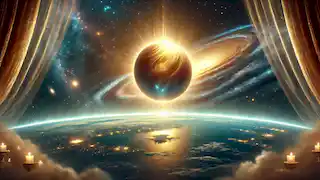{{{_intro}}}
In the ancient times, long before the birth of humankind, the cosmos lay in an endless ocean of darkness. There was no earth, no sky, no stars to light the heavens. All that existed was the infinite and timeless energy of creation, waiting to be molded into form. The universe, dormant and silent, awaited its moment of birth. This is the story of Brahma, the first being to arise from the cosmic waters and the god responsible for creation itself in Indian mythology. It is the story of his emergence, his divine task, and the start of all life and matter. Before the universe as we know it took form, there was only the great cosmic ocean—limitless, unfathomable, and without end. It stretched out in all directions, neither cold nor hot, neither still nor moving. In these primordial waters, the seed of all creation lay hidden, resting until the right moment would call it forth. From this great ocean emerged a brilliant and massive golden egg, glowing with an ethereal light. It floated in the waters, cradled by the void, containing within it the potential for everything that was yet to be. This egg was the "Hiranyagarbha," the womb of all creation. Within it resided Brahma, the creator god, though he had not yet awakened. Brahma remained in this state of rest, enveloped in a deep, mystical slumber. The golden egg glowed softly, radiating the power of creation but still incomplete. Outside, the vast ocean of darkness remained undisturbed, and time flowed without meaning, for there was no measure of it. But the time came when the universe demanded to be born. The egg began to crack, and from within, Brahma stirred. The light inside grew brighter and brighter until the shell of the egg shattered with a resounding cosmic sound—a sound so profound that it echoed across the void and became the first vibration, the very sound of existence itself: "Aum." With this sound, Brahma emerged from the golden egg, fully formed and radiant with divine power. He looked out over the great cosmic ocean, and in that moment, he realized that he was alone. He understood his purpose—he had been born to create the universe, to bring forth life, to give form to the formless. Brahma floated above the primordial waters, lost in thought. Though he possessed immense power, the task before him seemed overwhelming. He had no form, no structure, no guidance. Everything was yet to be created—the stars, the planets, the heavens, and the earth. He closed his eyes and meditated deeply, seeking the knowledge within himself. As he meditated, a lotus flower, resplendent and glowing, bloomed from his navel. This lotus symbolized purity, life, and potential, but Brahma knew he needed more than symbols. He needed wisdom to guide his creation. Brahma meditated for aeons, and in this state of contemplation, his thoughts turned to the three fundamental qualities of existence: Sattva (goodness), Rajas (passion), and Tamas (ignorance). These three qualities, he understood, would become the foundation of the universe. Everything that existed would possess a balance of these three qualities in different proportions. When Brahma opened his eyes, the knowledge of creation filled his being. He now knew how to proceed, how to craft the worlds from the nothingness around him. But he also knew that creation could not be done in solitude. He required the aid of other divine beings to bring balance and stability to the universe. Before beginning the physical act of creation, Brahma understood the need for wisdom, knowledge, and guidance. And so, from his own breath, he created the four Vedas—sacred texts that would serve as the foundation of all knowledge in the universe. The Vedas were filled with hymns, prayers, rituals, and instructions, containing the cosmic truths that would govern the creation and existence of all life. Brahma uttered their sacred words, and their divine wisdom flowed into the empty void. 1. Rig Veda – The first of the Vedas contained hymns that praised the divine forces of nature. These hymns were the songs of creation, celebrating the elements that would shape the universe. 2. Sama Veda – The second Veda was the Veda of melodies. It was filled with chants and music that would infuse the creation with harmony and rhythm, ensuring that the cosmos moved in a perfect and sacred dance. 3. Yajur Veda – The third Veda was the Veda of sacrifice. It held the rituals that would govern the laws of nature and ensure that balance was maintained between the forces of creation and destruction. 4. Atharva Veda – The fourth and final Veda contained spells, incantations, and the practical knowledge that would protect the created beings from harm, sickness, and evil. With the Vedas created, Brahma was ready to begin the physical process of creation. Brahma looked out over the vast, empty expanse of the universe. He knew that before life could exist, he had to bring forth the elements—the building blocks of creation. From his mind, he created the ether, the vast space that would hold the universe. This ether stretched out in all directions, limitless and ever-expanding. Then, from the ether, he created air—the breath of life. The winds began to stir and flow through the ether, bringing movement and energy. Next, Brahma created fire, the essence of light and heat. The fire burned brightly, illuminating the darkness and bringing warmth to the cold emptiness. This fire would become the stars, the suns that would light the heavens. Then, Brahma created water—the source of life, the flowing rivers and oceans that would nourish the earth. Water, with its fluid nature, brought the first sense of form to the universe. Finally, Brahma created earth—the solid ground that would become the foundation for life. From the earth, all things would grow, all beings would take form, and the cycle of birth and death would begin. With the elements in place, Brahma looked upon his creation and saw that it was beautiful, but still incomplete. Life had yet to emerge. Brahma knew that in order for the universe to function, it needed balance. And so, from his mind, he created two opposing forces: the Devas (gods) and the Asuras (demons). The Devas were beings of light, goodness, and order. They would help maintain balance in the universe, ensuring that creation flourished and that life continued. Among them were gods like Indra, the god of thunder and rain, and Agni, the god of fire. On the other side were the Asuras, beings of chaos, darkness, and destruction. They would challenge the Devas, ensuring that creation did not stagnate and that change, both good and bad, was a part of the universe. The Asuras were powerful, and they often sought to overthrow the Devas to take control of creation. Brahma understood that both forces were necessary for the universe to function. Without the Devas, there would be no order, and without the Asuras, there would be no change or evolution. And so, the eternal struggle between the Devas and Asuras began—a cosmic dance of light and darkness, creation and destruction. With the universe now filled with elements and divine beings, Brahma turned his attention to the creation of life. He knew that life must be diverse, capable of growth, reproduction, and transformation. From his thoughts, Brahma created the Prajapatis, the progenitors of all living beings. These divine beings would bring forth the various forms of life, from the smallest insect to the largest beast, and eventually, humankind. The Prajapatis spread out across the earth, creating the flora and fauna that would populate the world. Trees, plants, and flowers bloomed in the fertile earth, while animals of all shapes and sizes began to roam the land. Birds took to the skies, and fish swam in the oceans. Brahma watched as life flourished, but he knew that something was still missing. The universe needed beings of intelligence, beings who could think, create, and understand the divine order of the cosmos. Brahma then created humanity, beings made in his own image, with the capacity for reason, creativity, and spiritual understanding. He breathed life into the first humans, giving them the power to shape their own destinies and the ability to connect with the divine. These humans were given the gift of free will, the ability to choose their paths, to learn, and to grow. Brahma saw in them the potential for greatness, but also the potential for destruction. He knew that they would face many challenges, but he trusted that they would ultimately find their way. The humans spread across the earth, forming societies, building civilizations, and creating art, music, and knowledge. They became the caretakers of the world, responsible for maintaining the balance between nature and the divine. Brahma's work was complete, but he knew that creation was not a static process. The universe would go through cycles of birth, growth, decay, and destruction. This cycle, known as the "Yugas," would repeat endlessly, with each Yuga representing a different phase of the universe's existence. In the first Yuga, known as the Satya Yuga, the world was pure and filled with righteousness. But as time passed, the universe would enter the Treta Yuga, then the Dwapara Yuga, and finally the Kali Yuga—a time of darkness and ignorance. Each Yuga would bring its own challenges, and at the end of the Kali Yuga, the universe would be destroyed, only to be reborn again. Brahma would once again create the cosmos, and the cycle would begin anew. Though Brahma was the creator, he was not the only force in the universe. Vishnu, the preserver, was tasked with maintaining balance, ensuring that creation did not fall into chaos. He would descend to the world in various avatars whenever the balance was threatened, protecting the innocent and restoring order. Shiva, the destroyer, was the force of transformation. He would destroy the universe at the end of each cycle, making way for new creation. But his destruction was not an end—it was a necessary part of the cosmic process, allowing for rebirth and renewal. Brahma, Vishnu, and Shiva together formed the Trimurti, the three aspects of the divine responsible for creation, preservation, and destruction. As the universe continued to evolve, Brahma retreated into deep meditation. He knew that his role as creator was complete for now, but he would always be present, watching over the cosmos, ready to begin the process of creation once again when the time came. In his meditation, Brahma contemplated the infinite nature of the universe, the cycles of life and death, and the ultimate goal of all beings—to achieve union with the divine. He understood that the universe was a reflection of the divine mind, constantly in motion, constantly changing, but always connected to the source of all creation. And so, Brahma remained, floating above the cosmic waters, his mind filled with the knowledge of the universe, waiting for the next cycle of creation to begin. The tale of Brahma's birth and his creation of the universe has been passed down through the ages, a story of divine power, wisdom, and balance. It reminds us of the eternal cycles of existence, the importance of creation, and the delicate balance between order and chaos. Brahma's legacy lives on in the Vedas, in the natural world, and in the hearts of all beings. His story is a reminder that we are all part of the great cosmic dance, connected to the divine, and responsible for maintaining the balance of creation.The Primordial Waters and the Golden Egg
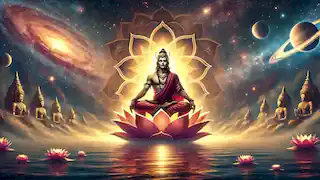
Brahma's Contemplation
The Creation of the Vedas
The Birth of the Elements
The Creation of the Devas and Asuras
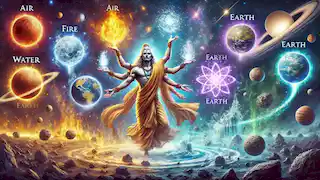
The Creation of Life
The Creation of Humanity
The Cycle of Creation and Destruction
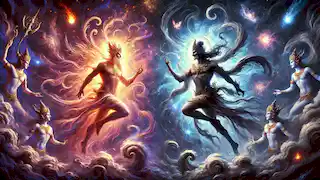
The Role of Vishnu and Shiva
The Eternal Meditation of Brahma
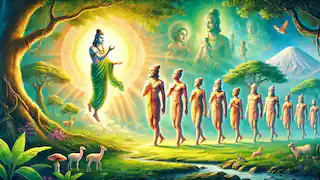
Epilogue: The Legacy of Brahma
